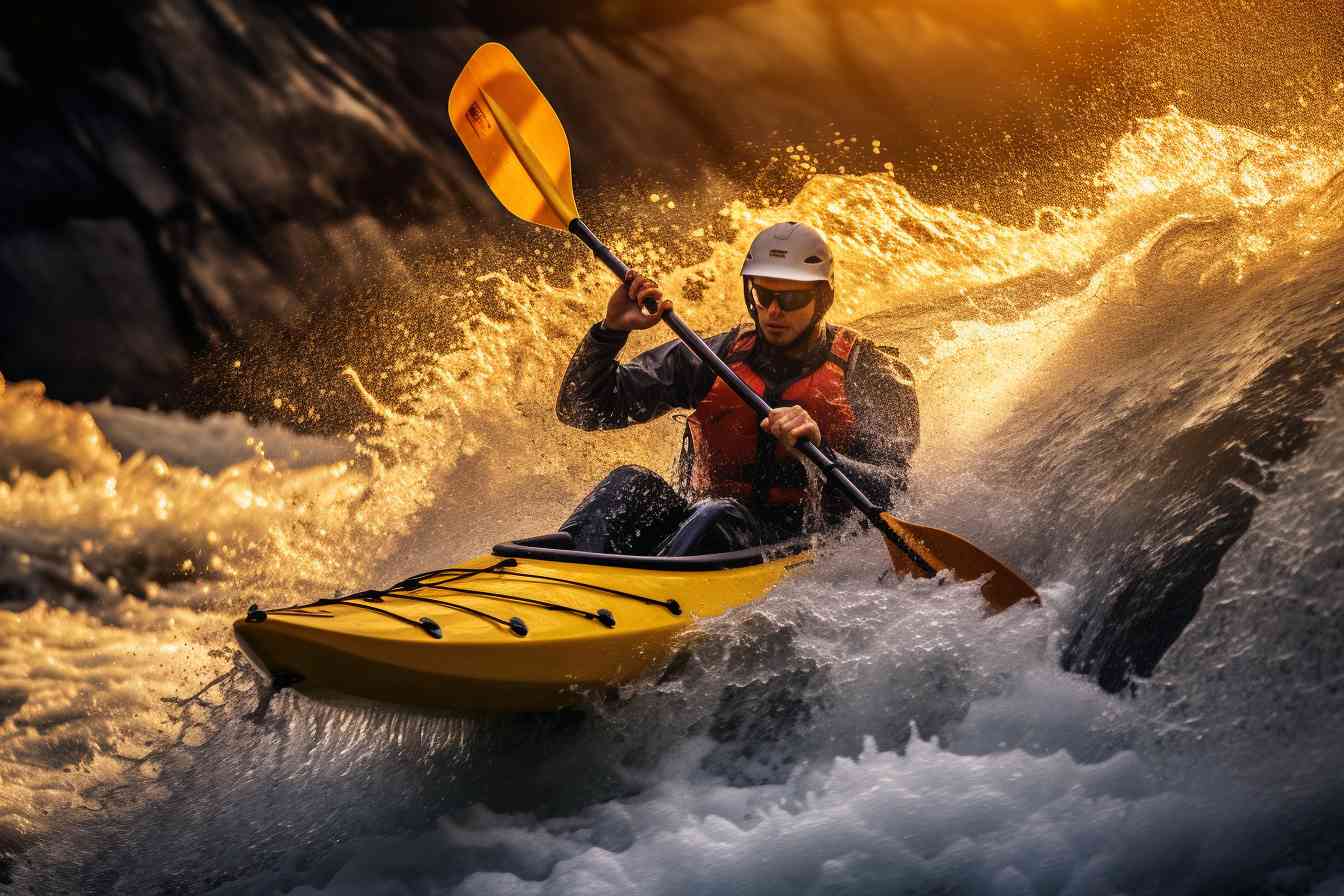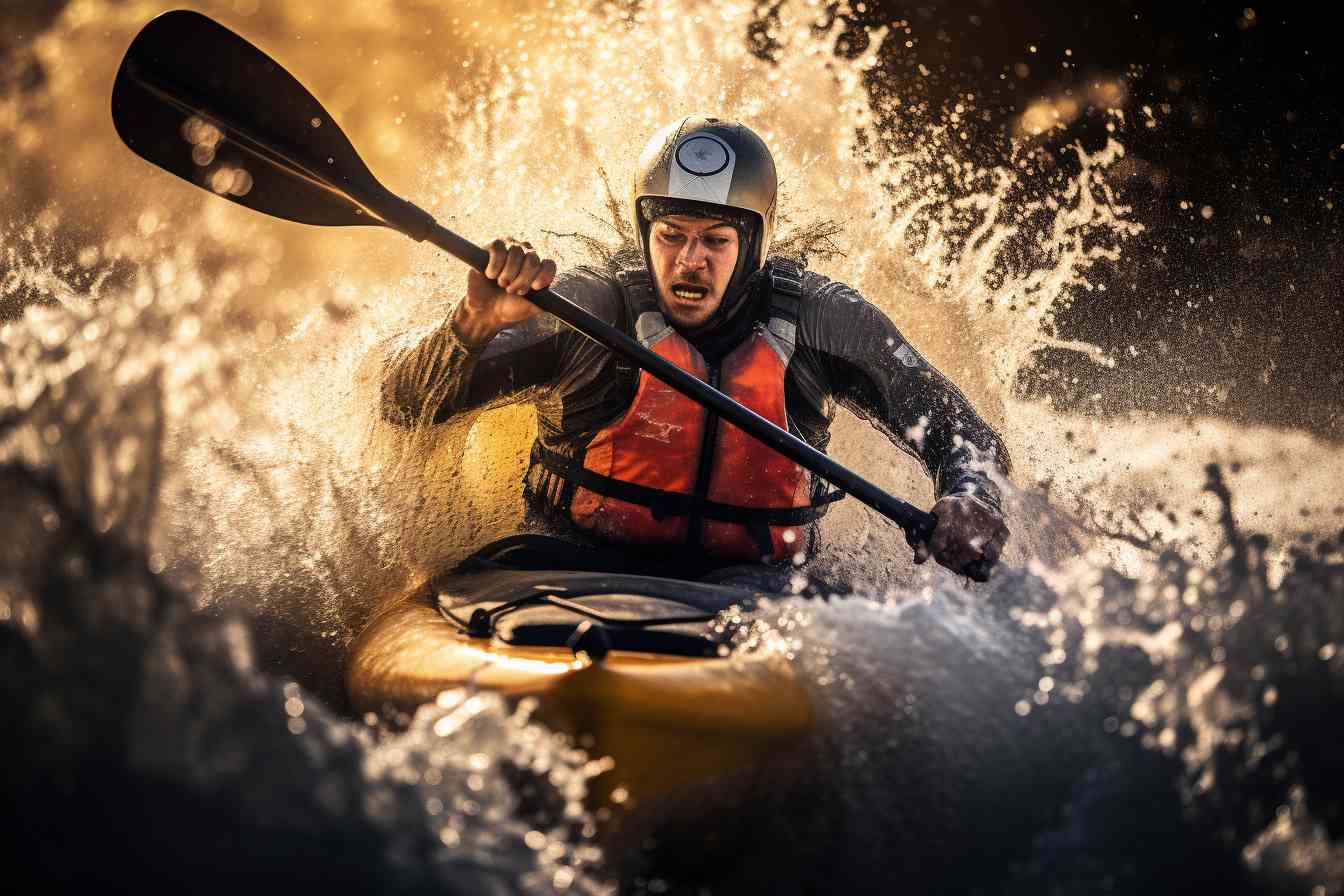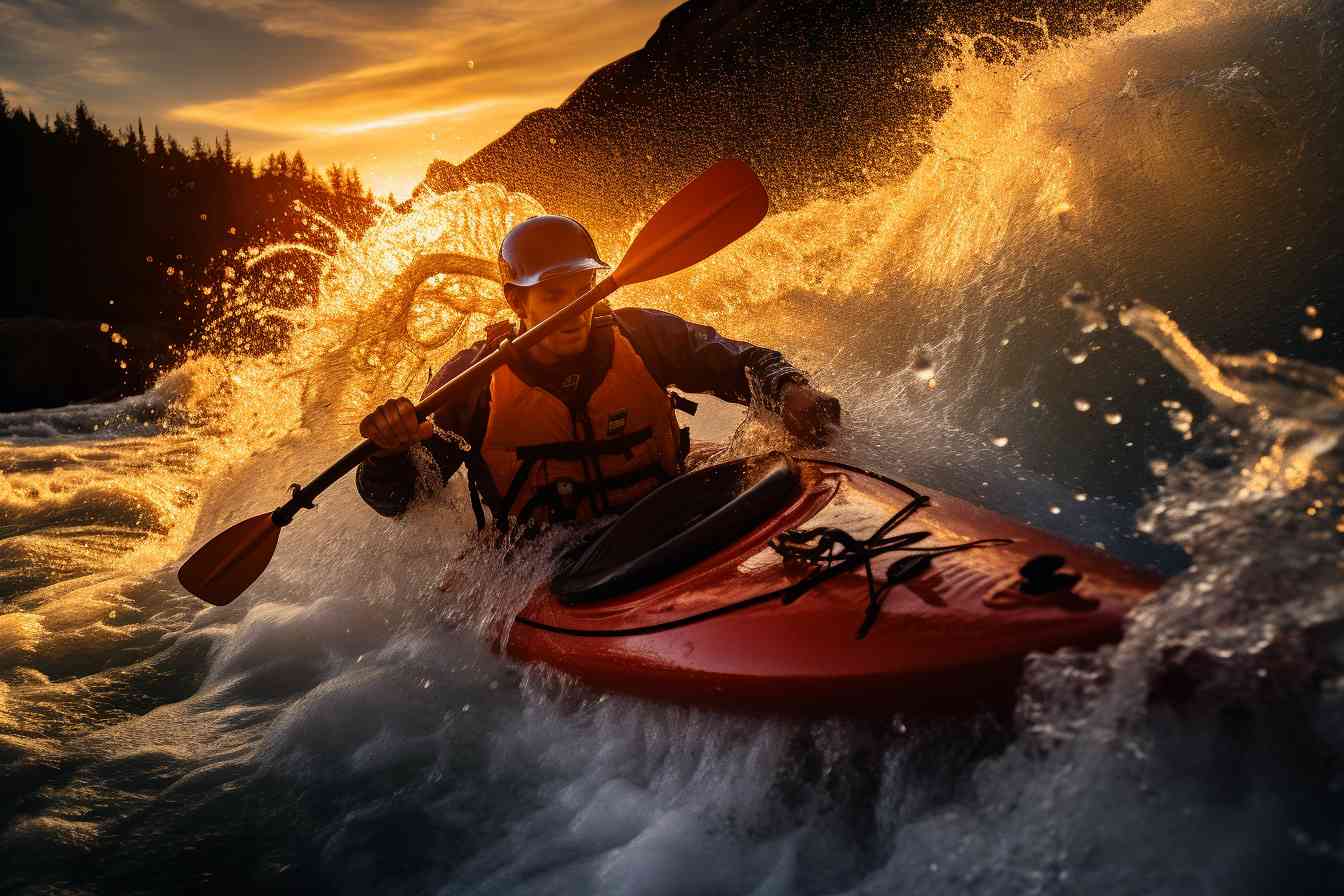Intro: How To Train For Kayaking

Well, what a pleasure to meet you all again, paddling enthusiasts! Ready to put some muscle into kayaking? Excellent! A healthy dose of strength, endurance, flexibility and balance— that’s what we’re aiming for. Now, let me tell you— training for kayaking isn’t a walk in the park or a breeze in the summer. It requires dedication, time, and effort.
Upper body strength – crucial for kayakers. Here, we’re talkin’ about your arms, shoulders and core muscles. You have to keep them toned and strong as they play a significant role in controlling your stroke and keeping balance in the kayak. Lifting weights, push-ups, pull ups, and rows will do wonders here. But remember, don’t forget to stretch! You want your muscles flexible, not tight.
Endurance training— that’s your best friend there. It’ll help you become resilient during long paddling excursions. Cycling, swimming, or jogging can help increase your cardiovascular fitness which is integral for endurance.
Balance and flexibility— well, they’re pretty darn important too! Yoga, pilates, or martial arts, can be advantageous in improving your kayak handling. They help in better paddle strokes and prevent you from flipping over.
And to top it off, practice makes perfect, guys! It’s beneficial to spend as much time as possible out on the water, mastering your skill. Building up your strength and endurance isn’t an overnight process— it’s gradual, and patience pays off.
Oh, and hydration— can’t stress that enough. Always keep yourself hydrated during your workout sessions to prevent muscle cramps. And remember, healthy eating plays a pivotal role in providing required energy and building strength. So ensure you feed your body well!
Well, that’s all for now my paddling maestros! May your training get you poised for a delightful day on the water. Until next time, paddle safe, stay fit!
How Do You Build Strength For Kayaking?

Well, let me put it this way – building strength for kayaking? It’s a no-brainer, folks. You start with a simple and pretty direct formula, just like making a mean apple pie – consistency, resilience, and the right blend of workouts. No rocket science, right?
You know what gets me buzzing, though? The concept of paddling in itself. It’s a full body workout, believe it or not. Every single muscle in your body should be humming by the time you’re done. Which means, the first thing on your menu is strengthening your core, but don’t ignore those arms and shoulders either – hey’re your paddling powerhouses, after all.
Now, for a real strength-building routine, you gotta get up close and personal with the weights. Lifting weights can really boost your strength and endurance. Traditional exercises like deadlifts, bench presses, and squats can be game changers. Mix them up with some kettlebell swings and you’re on the right track!
Plus, I wouldn’t just stop there. Yoga and Pilates, they’re gems. I swear. They help improve balance, control, and flexibility which are super crucial for kayaking.
And, oh boy – don’t even get me started on the importance of a well-rounded cardio routine. Running, cycling, or even brisk walking can help. Cardio can improve stamina and ensure you’re able to paddle longer.
Remember, practice makes perfect, right? So, the best strength-training drill involves getting into the kayak and paddling away. There is nothing quite like embodying the real thing, that’s what I always say.
Anyway, training for kayaking? It’s all about balance – finding the sweet spot between power, control, and endurance. A blend of strength-building exercises, cardio, and flexibility training seems to tick all those boxes. Happy training, fellow kayaking enthusiasts!
Can You Get Fit Kayaking?

Oh, absolutely! Kayaking is a fantastic way to build your physical fitness. When paddling through water with a certain level of assertiveness, you’re working your arms, back, shoulders, and even your legs. You’d be amazed at what a good cardiovascular workout kayaking can be. There’s no denying that it gets your heart rate up, but that isn’t all! Kayaking can also help with enhancing your core strength, as balance and stability in the water require a great deal of abdominal control.
But, it’s not just about the physical benefits. Kayaking is also a great mental workout. It requires concentration and problem-solving, particularly when navigating rapids or other challenging water conditions. And let’s not forget about the tranquility of the water – it can be the perfect therapy after a hectic day. It’s like meditation…with a splash of adventure.
But do remember, like with any sport, you need to train adequately to prevent injury and improve stamina.
Starting slow, gradually increasing your distance and intensity, focusing on technique, and including strengthening and flexibility exercises in your training routine can help you get fit for kayaking. Be consistent with your training, and slowly but surely, you will see improvements not just in your kayaking skills, but also in your overall fitness and wellbeing. So, get out there and paddle your way to fitness! It’s a whole lot of fun!
How Can I Improve My Kayaking Skills?

Well, pal, if you’re asking how to beef up those kayaking skills, I gotta tell you – it’s not a walk in the park, but it’s sure as heck worth it. First of all, you’ll want to get used to the water. Yeah, I know, kinda obvious, right? But I mean really cozy up to it – get comfortable in the water. If you can swim, great; if not, I highly recommend you learn.
Don’t neglect strength training, either. This isn’t just a leisurely paddle around the pond, buddy. Your core and upper-body strength are going to be the bread and butter of your kayaking experience, so hit the gym and focus on those areas.
Speaking of paddling, you’re gonna need to learn some techniques. There’s a right way and a wrong way to paddle, you know. It’s all in the torso twist, not arm strength – a lot of rookies make that mistake. Find a good instructor or hit up some online resources, and practice, practice, practice!
Also, remember to learn and understand the different types of water. Each has its own traits, and they might just throw you for a loop if you’re not ready. Rivers, lakes, and ocean waves all require different techniques and approaches.
Lastly, always remember…safety first, sport second. Get the right gear, like life vests, helmets, and appropriate clothing. Don’t test the waters in an unsafe manner, no matter how appealing it might seem. So there you have it – some ol’ food for thought on your journey to become a seasoned kayaker. Now, get out there and show that water who’s boss!
What Is The First Rule Of Kayaking?
Oh, how I love the feel of the paddle against the water! Kayaking, my dear friend, is one of life’s greatest pleasures. It’s a dance, really, between you and the water. But as with any dance, one has to know the steps. So what’s the first rule of kayaking, you ask? Let’s take a gentle paddle into that topic.
Pardon me for sounding foreboding but rule number one in kayaking is safety. Sorry, but I ain’t sugarcoating, it’s the raw truth. The sport is as fun as they come, but it ain’t no joke. Always, and I mean always, wear a life jacket. You might think you’re an excellent swimmer, but the water can be unpredictable, just like life itself. Also, should unwelcome circumstances occur—God forbid—like capsizing, that good ole life jacket will keep you afloat while you pull yourself together and remount your trusty vessel.
Now, speaking of capsizing, it’s important to learn how to flip that kayak right side up again. Practise it. In fact, make sure it’s a piece of cake before venturing into deeper waters. This might seem a bit scary at first, but it’ll become second nature before you know it. So, there you have it, safety first and everything else follows.
Paddling along and learning the ropes, there’s a certain poetry to it, don’t you think? And remember, the aim of the game is to enjoy the ride, not just to reach the destination. Isn’t that a motto for life, too? Well, back to kayaking. Let’s keep paddling!
Oh!—don’t forget, it’s perfectly okay to make mistakes when you’re starting out. You’re learning, after all! It’s all part of the process. So don’t let that put a damper on your spirits. Just keep paddling, keep learning, and always remember—the first rule of kayaking is safety. Now grab your paddle, strap on your life jacket, and let’s get out there on that crystal clear water!
Exercises For Getting In And Out Of Kayak
I reckon if you’re planning on taking up kayaking or improving your kayaking skills, we got just the right stuff for you. You see, one of the most vital aspects of kayaking is to be able to get in and out of the kayak with ease and confidence. So here are some exercises to help you do just that:
-
Leg Stretches: You’re gonna need flexibility, especially in your legs. A couple of leg stretches each day to become limber will make a world of difference. Toe touches, lunges, and hamstring stretches—all of these will prepare your legs for the maneuvering they’ll need to do.
-
Arm Strength Exercises: These are to give you all the force you need when pushing yourself up or lowering yourself down into the kayak. Push-ups, pull-ups, and dips – this trio can provide a significant boost to your arm strength, you bet.
-
Core Conditioning: A strong midsection helps ensure stability while entering and exiting your kayak. Planks, bicycle crunches, or Russian twists can help enhance your core strength.
-
Balance Exercises: You may find this a tad bit unusual, but you need good balance to get in and out of a kayak, mate. Yoga or simple balance-centric exercises such as standing on one foot are fantastic ways to improve balance over time.
-
Flexibility Training: Remember, being flexible can make the process a lot easier. Stretching regularly can significantly enhance your flexibility.
-
Practice the Seated Pushup: Practice simulating the motion of pushing oneself up from a seated position, similar to getting out of a kayak. This can be done on any low-seated surface, such as a porch step or a sturdy bench.
-
Water Confidence Exercises: If you aren’t comfortable in the water, exiting a kayak can be nerve-racking. Swimming drills or just spending time in the water can foster confidence.
-
Simulation Practice: Use a chair or bench to practice getting in and out. This can help familiarize your body with the movements and transitions involved.
-
Deep Squats: A great way to build lower body strength. This exercise will help you squat down into, and stand up out of, your kayak with greater ease.
-
Prone to Stand: Lying flat on your stomach, push upward with both hands till you’re in the ‘plank’ position. Then, step forward with one foot, followed by the other, into a standing position. This simulation helps you seamlessly get out of a kayak.
Remember, practice, patience and the right technique are key. The more you train, the more natural these movements will become. Happy kayaking, folks!
Final Verdict
In the end, it all boils down to one thing – nailing the perfect harmony of strength, endurance, and skill. Training for kayaking is not a walk in the park, but trust me, conquering those raging rivers makes all the sweat and effort worth it.
First and foremost, you gotta strengthen your core. “Why?” you might ask. Well, your core is the powerhouse of your body, steering, and balancing your kayak as you cut through the water depends heavily on it. Work it out with exercises like planks, sit-ups, or the Russian twist. Don’t forget about your upper body either – vigorous paddling requires robust arms and shoulders. Weight lifting can be your go-to here.
Now, onto stamina. See, kayaking ain’t a sprint; it’s more of a marathon. You gotta keep going for a long stretch of time. So, cardio exercises should be on top of your list – running or biking, take your pick!
Lastly, it’s all about technique. But, ah – practicing on dry land won’t cut it. You need to get in a kayak, get a feel for the waves, understand the rhythm. Spend time on the water, learn the strokes, the turns. And remember, safety first. Know the drill for what to do if you capsize.
So, that’s the nitty gritty of it. A combo of strength training, cardio, and on-water practice – that’s your ticket to becoming a pro kayaker. Ain’t easy, but boy, is it thrilling or what! Happy paddling, folks!
Frequently Asked Questions
How do I start training for kayaking?
Firstly, get yourself familiar with the basics of kayaking. Join a class or hire an instructor. Alongside, build up your physical strength – especially your core and upper body. Cardiovascular endurance is also crucial.
What specific exercises should I focus on for kayaking training?
Focus on exercises that strengthen the core and upper body. These might include sit-ups, plank, push-ups, tricep dips, and resistance band workouts. Cardio training, like swimming or running, is also key.
How often should I train for kayaking?
Ideally, aim for 3-5 days a week. Remember, consistency is king when it comes to training. Listen to your body, though, and give yourself ample time to recover to avoid burning out.
Is it necessary to take swimming lessons before kayaking?
Absolutely! Even though your aim is to stay in the kayak, knowing how to swim is a safety must. It’s comforting to know you can handle yourself in the water in case of an unexpected capsize.
How can I improve my kayaking technique?
Practice, practice, and more practice. Also, consider hiring a qualified instructor who can observe your style and offer personalized feedback and guidance.
What is the importance of a proper paddling technique in kayaking?
Proper technique is key to efficient, powerful, and injury-free paddling. It allows for more control over the kayak and makes paddling less tiring.
How does flexibility impact my kayaking training?
Greater flexibility helps improve your paddling technique, reduce the strain on your muscles, and lower your risk of injury. So, don’t skimp on those stretching exercises.
Do I need to follow a nutritional plan while training for kayaking?
Absolutely! Just like any other sport, good nutrition is vital. It provides the energy you need during training and helps your body recover quicker post-workout.
How long should I train before I can go out on a kayaking trip?
That depends on your physical fitness and familiarity with kayaking. I’d say give it a few weeks or months of regular practice and training. Always ensure you are comfortable and safe.
Is it possible to overtrain in kayaking?
Yes, you can. Overtraining can lead to injuries and burnout. It’s important to listen to your body and take rest days to allow your muscles to recover and strengthen.

